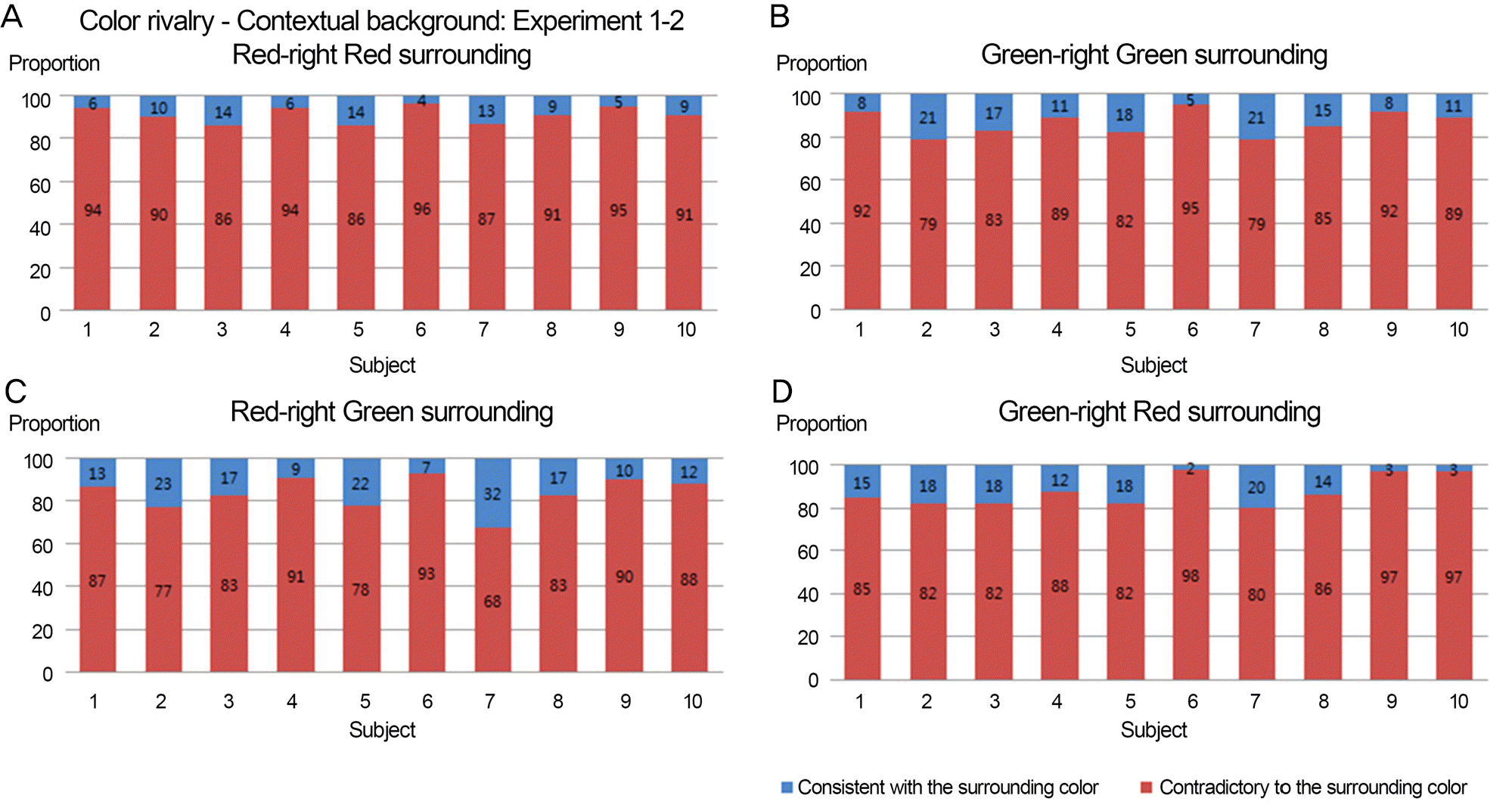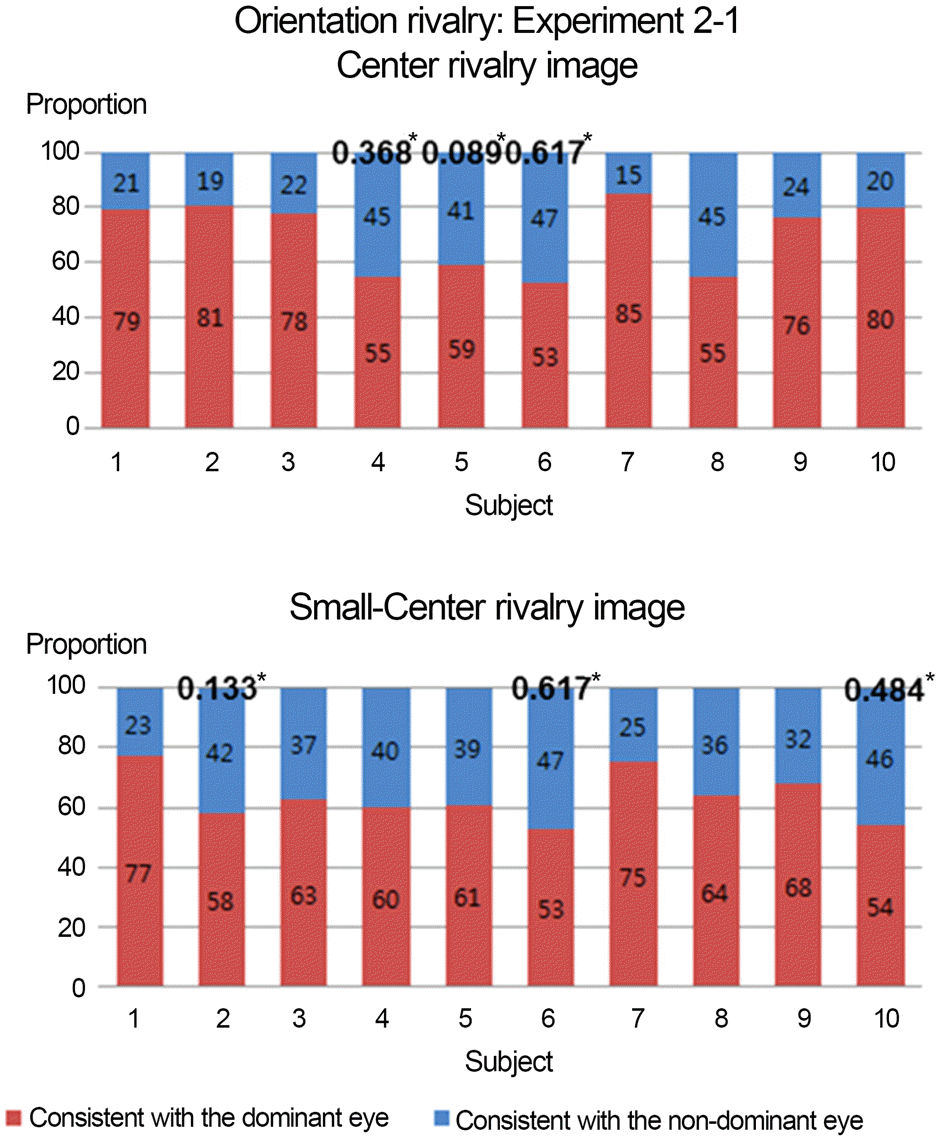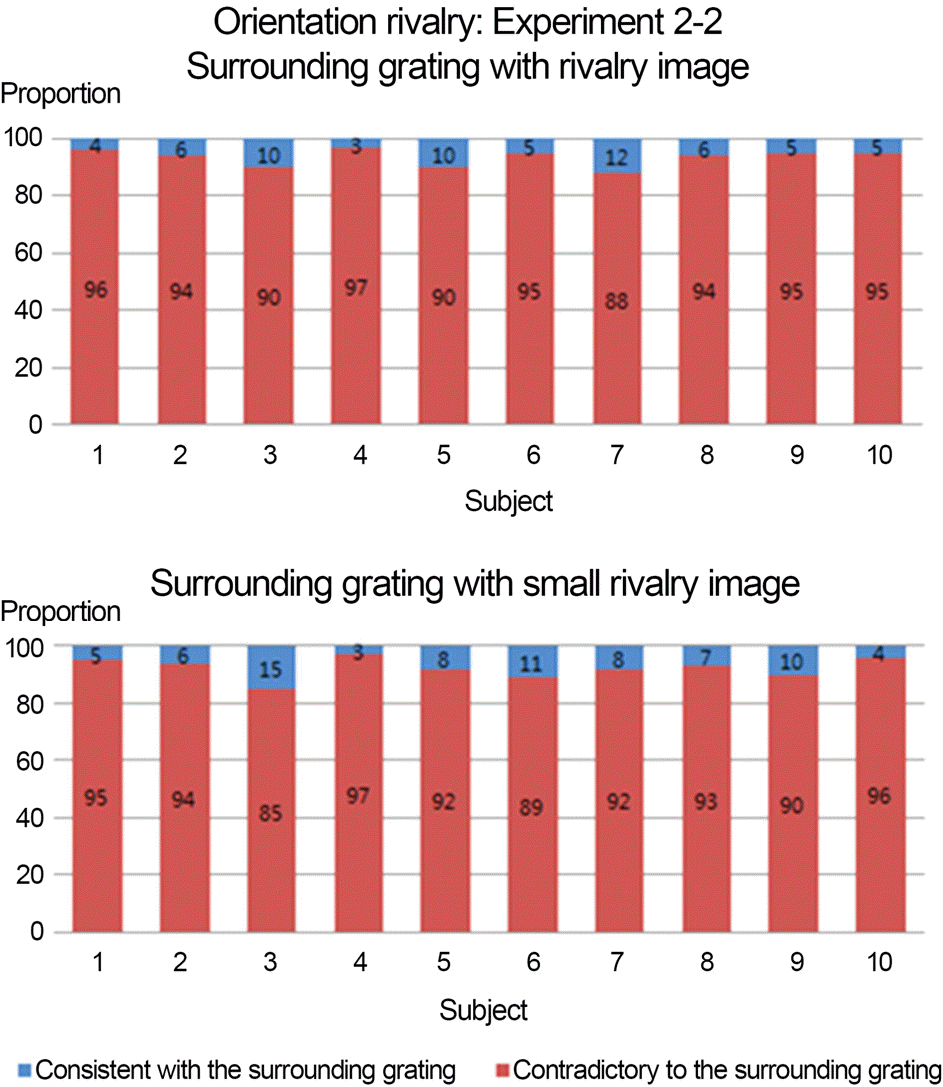Abstract
Purpose
We investigated the effects of dominant eye and contextual background on predominance during binocular rivalry.
Methods
10 subjects were recruited for the present study. Dominant eye was determined using the hole-in-the-card test. In ex-periment 1, subjects viewed the stimuli through anaglyph filters and reported the predominance of color. The subject’s re-sponses were compared with the color on the dominant eye. To investigate the influence of color dominance and contextual col-or, we conducted the experiment with added contextual color information target through switched-anaglyph filters. In experiment 2, the subject viewed the stimuli through the polarized filters and reported the predominance of orientation. The subject's re-sponses were compared with the grating on dominant eye. To rule out the effect of stimulus size, we conducted the experiment with a smaller target. We designed the additional experiment to investigate the influence of contextual grating information on bin-ocular rivalry.
Results
10 subjects were evaluated. In experiment 1, 8 of 10 subjects reported that eye preference was highly correlated with dominant eye. This finding is significant without reference to color. In experiment 2, 7 of 10 subjects reported that eye preference was highly correlated with dominant eye. This finding is significant without reference to size. In experiment 1-2 and 2-2, all sub-jects reported that predominance of context contradictory target increased.
Conclusions
We found the relationship between the dominant eye and eye preference. Experiment 1-2 and 2-2 showed that contradictory contextual information increases target predominance during binocular rivalry. Overall, our results indicate that the contextual background reduce the stimulus strength of the context-congruent target; it would correspond to an increase in the dominance duration of the context-contradictory target.
Go to : 
References
1. Mapp AP, Ono H, Barbeito R. What does the dominant eye domi-nate? A brief and somewhat contentious review. Percept Psychophys. 2003; 65:310–7.

2. Bannerman RL, Regener P, Sahraie A. Binocular rivalry: a window into emotional processing in aging. Psychol Aging. 2011; 26:372–80.

3. Han JH, Kim DS, Shin JC. Ocular dominance determined by near point of convergence test in intermittent exotropia. J Korean Ophthalmol Soc. 2000; 41:1592–6.
4. Koo BS, Cho YA. The relationship of dominant eye, dominant hand, and deviated eye in strabismus. J Korean Ophthalmol Soc. 1996; 37:1277–82.
6. Ehrenstein WH, Arnold-Schulz-Gahmen BE, Jaschinski W. Eye preference within the context of binocular functions. Graefes Arch Clin Exp Ophthalmol. 2005; 243:926–32.

7. Fagard J, Monzalvo-Lopez K, Mamassian P. Relationship between eye preference and binocular rivalry, and between eye-hand prefer-ence and reading ability in children. Dev Psychobiol. 2008; 50:789–98.

8. Handa T, Mukuno K, Uozato H. . Effects of dominant and non-dominant eyes in binocular rivalry. Optom Vis Sci. 2004; 81:377–83.

9. Dodrill CB, Thoreson NS. Reliability of the lateral dominance examination. J Clin Exp Neuropsychol. 1993; 15:183–90.

10. Levelt WJ. On Binocular Rivalry. Soesterberg: Institute for Perception RVO-TNO;1965. p. 1–110.
12. Hollins M. The effect of contrast on the completeness of binocular rivalry suppression. Percept Psychophys. 1980; 27:550–6.

13. Blake R, Yu K, Lokey M, Norman H. Binocular rivalry and motion perception. J Cogn Neurosci. 1998; 10:46–60.

14. Chong SC, Tadin D, Blake R. Endogenous attention prolongs domi-nance durations in binocular rivalry. J Vis. 2005; 5:1004–12.

Go to : 
 | Figure 1.Stimuli used in the experiment 1. Each image was presented to the two eyes through anaglyph filters. White circle sur-rounding with black background (A), green background (B), and red background (C). |
 | Figure 2.Stimuli used in the experiment 2. Each image was presented to the two eyes through polarized filters. Rivalry target with-out background (A, D) with horizontal grating background (B, E) and with vertical grating background (C, F). |
 | Figure 4.Proportion of the cases contradictory to the surrounding context color. (A) Contextual background in color rivalry: Red-right Red surrounding. (B) Contextual background in color rivalry: Green-right Green surrounding. (C) Contextual back-ground in color rivalry: Red-right Green surrounding. (D) Contextual background in color rivalry: Green-right Red surrounding. |




 PDF
PDF ePub
ePub Citation
Citation Print
Print





 XML Download
XML Download